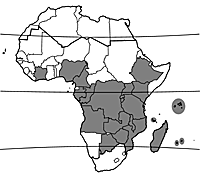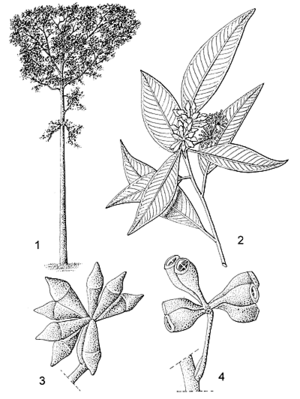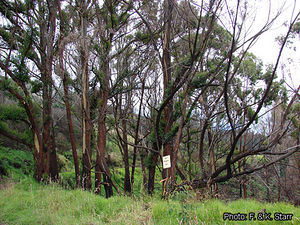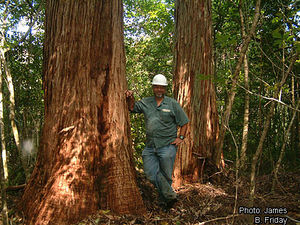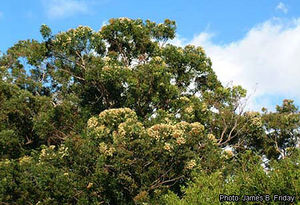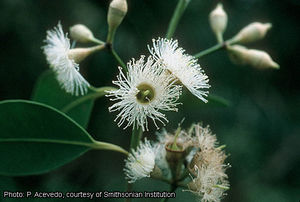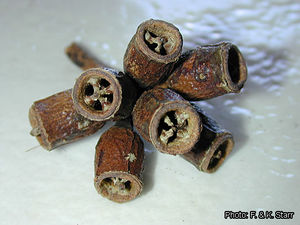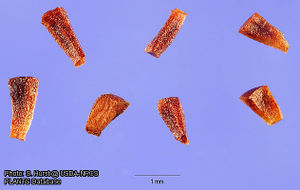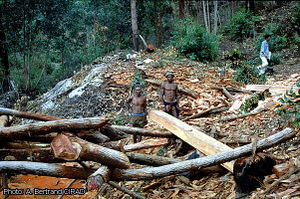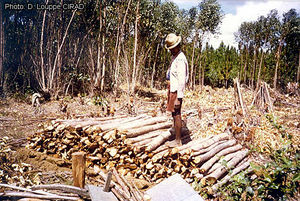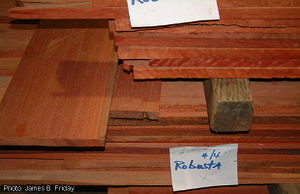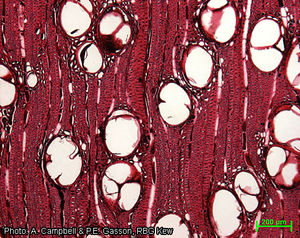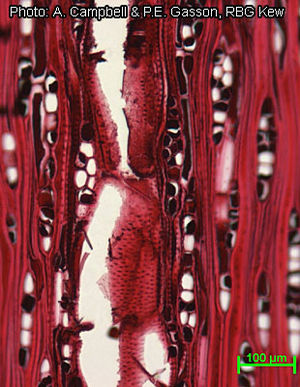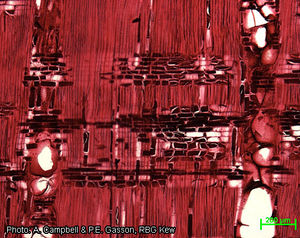Eucalyptus robusta (PROTA)
Introduction |
| General importance | |
| Geographic coverage Africa | |
| Geographic coverage World | |
| Spice / condiment | |
| Carbohydrate / starch | |
| Medicinal | |
| Timber | |
| Fuel | |
| Ornamental | |
| Forage / feed | |
| Fibre | |
| Climate change | |
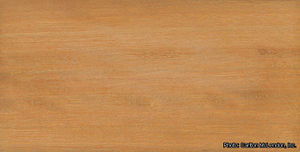
- Protologue: Spec. bot. New Holland 4: 39 (1795).
- Family: Myrtaceae
Vernacular names
- Swamp mahogany, swamp messmate, beakpod eucalyptus, Australian silk oak (En).
- Eucalyptus rouge, acajou des marais (Fr).
- Eucalipto robusto, eucalipto de folha larga (Po).
- Mkaratusi (Sw).
Origin and geographic distribution
Eucalyptus robusta is native to a narrow coastal area in south-eastern Australia, from southern Queensland to southern New South Wales. It is one of the most widely planted Eucalyptus species and it has been introduced into many tropical, subtropical, and warm-temperate areas, including many countries in tropical Africa. It is especially important in Madagascar, where it was introduced in the 1890s.
Uses
The wood is generally used for construction, poles, ordinary furniture, wheels, ship-building, wharf construction, shingles, pallets and boxes. The durability and strength of the wood make it highly regarded for stakes and fences; stakes last a long time in the ground and can be driven repeatedly without splitting. The wood makes attractive flooring, while its strength makes it suitable for construction. Quarter-sawn wood can be sliced into an attractive veneer suitable for plywood and panels. The wood is also suitable for mine props, railway sleepers, vehicle bodies, agricultural implements, food containers, joinery, turnery and musical instruments. It is an excellent fuelwood and makes good charcoal. It is also used for paper making, but for this purpose it is not as good as Eucalyptus globulus Labill. and Eucalyptus saligna Sm.
Eucalyptus robusta is a bee forage tree. It is used for reforestation and dune stabilization and it is planted to dry-out swamps, e.g. to combat malaria. It is sometimes used for windbreaks and wayside planting, and it has ornamental value.
In Gabon an infusion of the leaves is used for treatment of malarial fever, and in Chinese traditional medicine the leaves are also used against malaria. In Mauritius and Réunion the leaves are used for baths, inhalations and infusions to treat fever, colds, cough and influenza. Inhalation is also recommended for treatment of asthma and sinusitis, and infusions are taken against diabetes. A decoction is used in baths to treat stiffness, rheumatism and epilepsy. In Madagascar a handful of buds is rubbed and squeezed, and the sap is applied to the nostrils to relieve headache.
Production and international trade
For 1995 it was estimated that worldwide Eucalyptus plantations amounted to 14.6 million ha, of which 1.8 million ha in Africa. Madagascar has an estimated 151,000 ha, mainly Eucalyptus robusta.
Properties
The heartwood is pale red when freshly cut, turning orange-red or red-brown with age; it is clearly demarcated from the up to 5 cm wide, pale brown sapwood. The grain is interlocked, texture coarse. Quartersawn surfaces sometimes have a ribbon figure of light and dark stripes.
The wood is fairly heavy, with a density of 720–920 kg/m³ at 12% moisture content. The rates of shrinkage from green to oven dry are high: 5.4–9.7% radial and 8.3–12.0% tangential. The high shrinkage, coupled with the interlocked grain, makes Eucalyptus robusta a wood requiring careful drying. During drying distortion and splitting may occur; serious degrade can be avoided by air drying to a moisture content below 30% before kiln drying. In humid parts of Madagascar 2.5 cm thick boards need 3 months to dry to 30% moisture content, in drier parts only 1.5 month. The wood is not stable in service.
At 12% moisture content, the modulus of rupture is 95–201 N/mm², modulus of elasticity 9800–16,700 N/mm², compression parallel to grain 40–82 N/mm², shear 7–16 N/mm², cleavage 18–32 N/mm and Chalais-Meudon side hardness 3.2–6.7.
The wood works well and takes a good polish. It is somewhat abrasive, and planing may be affected by interlocked grain. Therefore, slow speeds and a cutting angle of 20° are recommended. Sawing and working properties are generally good, although gummy exudates may clog up saws. The wood holds nails well, but pre-boring is necessary to avoid splitting. It turns well, and paints and waxes satisfactorily. Gluing is fairly difficult. The wood is not suitable for steam-bending.
The wood is durable and can be used in moist conditions. The heartwood is resistant to attacks by fungi and most insects, including marine borers, and moderately resistant to termite attack. The sapwood is readily attacked by fungi and insects, including Lyctus borers. Thinner stems often mainly consist of sapwood and their durability is low. The heartwood is resistant to impregnation with preservatives, the sapwood is moderately resistant. The wood has an energy value of 19,600–20,500 kJ/kg.
The leaves yield 0.1–0.2% essential oil. The main components of the essential oil of leaves from DR Congo were p-cymene (27.3%), myrtenal (12.8%) and β-pinene (6.3%), α-terpineol (6.3%), 1,8-cineole (4.3%), limonene (3.5%) and cuminaldehyde (2.5%). The essential oil has shown antibacterial and antifungal activity. Ethanol extracts of the leaves have shown antioxidant activity. Phenolic compounds with activity against the malaria-inducing protozoan Plasmodium berghei have been isolated from the leaf. The bark contains 1.4% tannin, whereas the leaves may contain 12%.
Description
- Evergreen, medium-sized tree up to 30(–55) m tall; bole often relatively short, straight, up to 120 cm in diameter, on wet sites aerial roots up to 6 m high on the trunk may be present; bark rough, soft, spongy, fibrous, red-brown; crown spreading in trees growing in the open, and narrow in closely spaced plantations.
- Leaves alternate, simple and entire; stipules absent; petiole channelled, 1.5–3.5 cm long; blade broadly lanceolate, 8–18(–20) cm × 2.5–8 cm, long-acuminate at apex, glabrous, dark green above, pale green beneath, pinnately veined, aromatic when crushed.
- Inflorescence an axillary, simple, condensed and reduced, umbel-like dichasium, 5–15-flowered; peduncle broadly flattened, 13–35 mm long.
- Flowers bisexual, regular; pedicel angular and up to 9(–12) mm long; flower buds spindle-shaped, beaked, 10–30 mm × 6–8 mm, divided into a hypanthium (lower part) 6–7 mm × 6–8 mm, and a conical, beaked operculum (upper part) 10–14 mm × 6–8 mm, shed at anthesis; stamens numerous; ovary inferior, 3–4-celled.
- Fruit a thin-walled cylindrical to urn-shaped capsule (8–)10–18 mm × 6–11 (–12) mm, enclosed in a woody hypanthium, opening with 3–4 included to slightly exserted valves, many-seeded.
- Seeds cube-shaped or flat, 1–2 mm long, brown.
- Seedling with epigeal germination.
Other botanical information
Eucalyptus comprises about 800 species, endemic to Australia, except for about 10 species in the eastern part of South-East Asia. Many Eucalyptus species are cultivated outside their natural distribution area, in tropical, subtropical and temperate regions, because of their rapid growth and adaptation to a wide range of ecological conditions. In Africa Eucalyptus globulus has long been the most important Eucalyptus species, but its importance has declined, although it is still important in cooler climates. Nowadays the main commercial species in Africa are Eucalyptus grandis W.Hill ex Maiden in more fertile locations, Eucalyptus camaldulensis Dehnh. in drier regions, and Eucalyptus robusta in more tropical regions.
Eucalyptus is divided into several subgenera (7–10, depending on the author), which are subdivided into many sections and series. The results of phylogenetic studies within Eucalyptus suggest that the genus is polyphyletic, hence not of a single evolutionary origin, and consequently it has been proposed to divide the genus into several distinct genera. This has not yet been done, mainly because of the nomenclatural whirlpool this would bring about. Eucalyptus species hybridize easily, which adds to the taxonomic complexity.
Several natural hybrids involving Eucalyptus robusta have been reported.
Anatomy
Wood-anatomical description (IAWA hardwood codes):
- Growth rings: 2: growth ring boundaries indistinct or absent.
- Vessels: 5: wood diffuse-porous; (7: vessels in diagonal and/or radial pattern); 9: vessels exclusively solitary (90% or more); 13: simple perforation plates; 22: intervessel pits alternate; 26: intervessel pits medium (7–10 μm); 27: intervessel pits large (≥ 10 μm); 29: vestured pits; 31: vessel-ray pits with much reduced borders to apparently simple: pits rounded or angular; 32: vessel-ray pits with much reduced borders to apparently simple: pits horizontal (scalariform, gash-like) to vertical (palisade); 42: mean tangential diameter of vessel lumina 100–200 μm; (45: vessels of two distinct diameter classes, wood not ring-porous); 46: ≤ 5 vessels per square millimetre; 47: 5–20 vessels per square millimetre; 56: tyloses common.
- Tracheids and fibres: 60: vascular/vasicentric tracheids present; 62: fibres with distinctly bordered pits; 63: fibre pits common in both radial and tangential walls; 66: non-septate fibres present; 70: fibres very thick-walled.
- Axial parenchyma: 76: axial parenchyma diffuse; 79: axial parenchyma vasicentric; 80: axial parenchyma aliform; 81: axial parenchyma lozenge-aliform; 83: axial parenchyma confluent; 92: four (3–4) cells per parenchyma strand.
- Rays: 97: ray width 1–3 cells; 104: all ray cells procumbent; 106: body ray cells procumbent with one row of upright and/or square marginal cells; 116: ≥ 12 rays per mm.
Growth and development
The annual growth in height is usually 1.8–2.4 m during the first few years, slowing down to 1.5–1.8 m later. In Mauritius an annual height growth of 52 cm has been recorded. Trees start flowering when they are (3–)5 years old. Flowering is protandrous and the flowers are pollinated by insects. The fruits ripen 5–7 months after flowering. Seed dispersal is mainly by wind. Eucalyptus robusta regenerates freely, and dense thickets of saplings can be found near old stands.
Ecology
Eucalyptus robusta is grown from sea-level up to 1600 m altitude, in areas with a mean annual temperature of 16–28°C, a mean maximum temperature of the warmest month of 25–32°C, a mean minimum temperature of the coldest month of 3–12°C, and an average annual rainfall of 700–1800 mm, with a dry season of 1–4 months. In its area of natural distribution it grows in swamps, near salt-water estuaries and lagoons. It grows better on slopes, but cannot compete with other species. In Ethiopia it is planted in locations with deep soil and high rainfall. It tolerates prolonged flooding, but does not grow in stagnant water. It tolerates slightly saline soils and salty winds, and regenerates fast after fire.
Propagation and planting
The 1000-seed weight is 2–9 g. Seed can be stored for several years under dry, cold and airtight conditions. The seed is difficult to separate from the chaff (unfertilized or aborted ovules) in the ripe fruits. No pre-sowing treatment is required. Seed germinates easily with normal methods, with 80–85% germination in 7–10 days. Seedlings can be planted out in the field after (2–)4–6 months, when they are 20–30 cm tall. Cuttings taken from young seedlings and young coppice shoots have been successfully rooted, but cuttings have not been used on a commercial scale.
Management
Weeding is important during initial growth. The tree coppices well. For fuelwood, coppice rotations of 4–5 years are used, for pulpwood rotations of 8–10 years, and for saw logs rotations of 30–60 years. However, in plantations for fuelwood and charcoal in Madagascar, rotations as short as 2–3 years are common, whereas rotations of 8 years are considered optimal to maximize production.
Diseases and pests
Eucalyptus robusta is susceptible to the eucalyptus snout beetle (Gonipterus scutellatus), of which both the larval and adult stages cause damage, especially by feeding on the leaves. Repeated defoliation leads to stunted growth, and trees may die. Adults, larvae and eggs are carried on plants for planting and accompanying soil, whereas adults may also spread by flying. In Mauritius, France and Italy biological control using the egg parasite Anaphes nitens has been successful in reducing attacks. Chemical treatment is not recommended because of its adverse effects on honey bees visiting the trees. Gonipterus scutellatus is of Australian origin, and is recorded to be present in Kenya, Uganda, Malawi, Zimbabwe, Mozambique, Madagascar, Mauritius, South Africa, Swaziland and Lesotho. Differences in susceptibility exist between Eucalyptus spp., with Eucalyptus robusta belonging to the more susceptible species. Because of its susceptibility to the eucalyptus snout beetle, Eucalyptus robusta has been banned from Kenya. Young plants are susceptible to termite attack.
Harvesting
Wood in the living tree is subject to internal stresses that have built up during the life of the tree. These stresses may be released during all stages of harvesting and processing, resulting in spontaneous splitting and deformations. Furthermore, brittle heart is usually present, and small pin knots often occur.
Yield
In Madagascar yields of 7–36 m³/ha per year are attained. Coppice stands often outproduce seedling stands. A 10-year-old coppice stand in Hawaii produced 140 m³/ha, while an adjacent 12-year-old seedling stand yielded only 96 m³/ha.
Handling after harvest
Quartersawing of the logs is recommended to reduce splitting and deformations due to the release of internal stresses.
Genetic resources
The genetic base of Eucalyptus robusta in Madagascar is rather narrow, resulting in inbreeding, low-quality seeds and poor performance. Genetic improvement activities aim to broaden the genetic variation and produce improved material for village communities.
Breeding
In Madagascar farmers prefer genotypes with good coppicing ability, a thick bark for fire resistance, good juvenile vigour and high volume production for fuelwood and charcoal, whereas stem form and other morphological characteristics are less important. A provenance trial with 30 Australian provenances and 25 local provenances from Madagascar was planted, from which superior trees were selected for seed orchards.
Recurrent selection and open-pollinated recombination in different environments are applied to obtain genotypes with the desired traits. Hybridization of Eucalyptus robusta with Eucalyptus grandis is being tried out.
Prospects
Although Eucalyptus robusta is often considered too slow growing for productive purposes, it is popular in Madagascar because of its wood quality, hardiness, adaptation to various environments, excellent coppicing ability and fire-resistant bark. The wood of Eucalyptus robusta is well-suited for purposes requiring strength and durability and for finish work where an attractively figured, orange-red to reddish brown wood is desired. Eucalyptus robusta seems to have prospects in humid locations, as it is one of the few plantation species tolerating prolonged flooding.
Major references
- Bolza, E. & Keating, W.G., 1972. African timbers: the properties, uses and characteristics of 700 species. Division of Building Research, CSIRO, Melbourne, Australia. 710 pp.
- Chippendale, G.M., 1988. Myrtaceae - Eucalyptus, Angophora. In: George, A.S. (Editor). Flora of Australia, Volume 19. Australian Government Publishing Service, Canberra, Australia. 540 pp.
- Guéneau, P., 1969. Caractéristiques et utilisations de l’Eucalyptus robusta à Madagascar. Bois et Forêts des Tropiques 124: 53–65.
- Guéneau, P., Bedel, J. & Thiel, J., 1970–1975. Bois et essences malgaches. Centre Technique Forestier Tropical, Nogent-sur-Marne, France. 150 pp.
- Jacobs, M.R., 1981. Eucalypts for planting. 2nd Edition. FAO Forestry Series No 11. Food and Agriculture Organization of the United Nations, Rome, Italy. 677 pp.
- Keating, W.G. & Bolza, E., 1982. Characteristics, properties and uses of timbers. Vol.1: South East Asia, northern Australia and the Pacific. Inkata Press, Melbourne, Australia. 362 pp.
- Lamb, D., Johns, R.J., Keating, W.G., Ilic, J. & Jongkind, C.C.H., 1993. Eucalyptus L’Hér. In: Soerianegara, I. & Lemmens, R.H.M.J. (Editors). Plant Resources of South-East Asia No 5(1). Timber trees: Major commercial timbers. Pudoc Scientific Publishers, Wageningen, Netherlands. pp. 200–211.
- Takahashi, A., 1978. Compilation of data on the mechanical properties of foreign woods (part 3) Africa. Shimane University, Matsue, Japan, 248 pp.
- Verdcourt, B., 2001. Myrtaceae. In: Beentje, H.J. (Editor). Flora of Tropical East Africa. A.A. Balkema, Rotterdam, Netherlands. 89 pp.
- World Agroforestry Centre, undated. Agroforestree Database. [Internet] World Agroforestry Centre (ICRAF), Nairobi, Kenya. http://www.worldagroforestry.org/Sites/TreeDBS/aft.asp. May 2008.
Other references
- Amshoff, G.J.H., 1966. Myrtacées. Flore du Gabon. Volume 11. Muséum National d’Histoire Naturelle, Paris, France. pp. 3–33.
- Bazille, D. & Ducrocq, L., 2000. Caractérisation et dynamique des peuplements d’Eucalyptus robusta dans la zone nord-est d’Antananarivo. Rapport de stage. ESITPA, Val-de-Reuil, France. 45 pp.
- Bertrand, A., 1999. La dynamique séculaire des plantations d’eucalyptus sur les Hautes Terres malgaches. Le Flamboyant 49: 45–48.
- Chaix, G. & Razafimaharo, V., 1998. Eucalyptus robusta Smith. Le Flamboyant 48: 5–9.
- Cheng, Q. & Snyder, J.K., 1988. Revised structures of robustadials A and B from Eucalyptus robusta. Journal of Organic Chemistry 53(19): 4562–4567.
- Cimanga, K., Kambu, K., Tona, L., Aspers, S., De Bruyne, T., Hermans, N., Totté, J., Pieters, L. & Vlietinck, A.J., 2002. Correlation between chemical composition and antibacterial activity of essential oils of some aromatic medicinal plants growing in the Democratic Republic of Congo. Journal of Ethnopharmacology 79: 213–220.
- Coppen, J.J.W., 2002. Eucalyptus: the genus Eucalyptus. Medicinal and aromatic plants - industrial profiles, vol. 22. Taylor & Francis, London, United Kingdom. 450 pp.
- EPPO (European and Mediterranean Plant Protection Organization), 2005. Gonipterus gibberus and Gonipterus scutellatus. EPPO Bulletin 35: 368–370.
- Friis, I., 1995. Myrtaceae. In: Edwards, S., Mesfin Tadesse & Hedberg, I. (Editors). Flora of Ethiopia and Eritrea. Volume 2, part 2. Canellaceae to Euphorbiaceae. The National Herbarium, Addis Ababa University, Addis Ababa, Ethiopia and Department of Systematic Botany, Uppsala University, Uppsala, Sweden. pp. 71–106.
- Gurib-Fakim, A., Guého, J. & Bissoondoyal, M.D., 1996. Plantes médicinales de Maurice, tome 2. Editions de l’Océan Indien, Rose-Hill, Mauritius. 532 pp.
- Lavergne, R. & Véra, R., 1989. Médecine traditionelle et pharmacopée - Contribution aux études ethnobotaniques et floristiques à la Réunion. Agence de Coopération Culturelle et Technique, Paris, France. 236 pp.
- Lebot, V. & Ranaivoson, L., 1994. Eucalyptus genetic improvement in Madagascar. Forest Ecology and Management 63(2–3): 135–152.
- Parry, N.S., 1956. Tree planting practices in tropical Africa. FAO Forestry Development Paper No 8. FAO, Rome, Italy. 302 pp.
- Raponda-Walker, A. & Sillans, R., 1961. Les plantes utiles du Gabon. Paul Lechevalier, Paris, France. 614 pp.
- Streets, R.J., 1962. Exotic forest trees in the British Commonwealth. Clarendon Press, Oxford, United Kingdom. 765 pp.
- Webb, D.B., Wood, P.J., Smith, J.P. & Henman, G.S., 1984. A guide to species selection for tropical and sub-tropical plantations. 2nd Edition. Tropical Forestry Papers No 15. Commonwealth Forestry Institute, University of Oxford, United Kingdom. 256 pp.
- White, F., 1978. Myrtaceae. In: Launert, E. (Editor). Flora Zambesiaca. Volume 4. Flora Zambesiaca Managing Committee, London, United Kingdom. pp. 183–212.
Sources of illustration
- Lamb, D., Johns, R.J., Keating, W.G., Ilic, J. & Jongkind, C.C.H., 1993. Eucalyptus L’Hér. In: Soerianegara, I. & Lemmens, R.H.M.J. (Editors). Plant Resources of South-East Asia No 5(1). Timber trees: Major commercial timbers. Pudoc Scientific Publishers, Wageningen, Netherlands. pp. 200–211.
Author(s)
- R.B. Jiofack Tafokou, Ecologic Museum of Cameroon, P.O. Box 8038, Yaoundé, Cameroon
Correct citation of this article
Jiofack Tafokou, R.B., 2008. Eucalyptus robusta Sm. In: Louppe, D., Oteng-Amoako, A.A. & Brink, M. (Editors). PROTA (Plant Resources of Tropical Africa / Ressources végétales de l’Afrique tropicale), Wageningen, Netherlands. Accessed 17 December 2024.
- See the Prota4U database.

